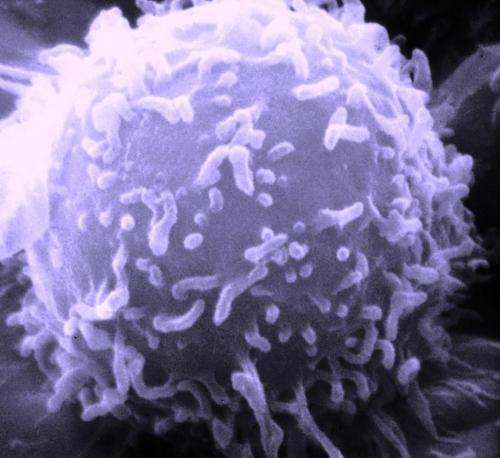Evolution may hold the key to more designer cancer drugs like Gleevec

This is the story of Abl and Src—two nearly identical protein kinases whose evolution may hold the key to unlocking new, highly specific cancer drugs.
Abl and Src are bad guys—oncogenes with a predilection to cause cancer in humans, mainly chronic myeloid leukemia (CML) and colon cancer. These two proteins are separated by 146 amino acids, and one big difference—Abl is susceptible to the cancer drug Gleevec, while Src is not.
Dorothee Kern, professor of biochemistry at Brandeis University and Howard Hughes Medical Institute investigator, unraveled the journey of these two proteins over one billion years of evolution, pinpointing the exact evolutionary shifts that caused Gleevec to bind well with one and poorly with the other. This new approach to researching enzymes and their binding sites may have a major impact on the development of rational drugs to fight cancer.
The findings were published in the journal Science and coauthored by Doug Theobald, professor of biochemistry, with Christopher Wilson, Roman Agafonov, Marc Hoemberger, Steffen Kutter, Jackson Halpin, Vanessa Buosi, Adelajda Zorba, Renee Otten and David Waterman.
When Gleevec hit the market in 2001, it was hailed as the magic bullet against cancer.
That's because most cancer drugs fight a scorched-earth campaign—killing as many healthy cells as cancerous ones. But Gleevec is specifically attracted only to Abl, the enzyme in cancerous cells responsible for growth and reproduction. Gleevec binds with Abl, deactivating it and stopping the spread of cancer in its tracks.
Developing more drugs to work like Gleevec—known as rational drug design —could create therapies that target specific enzymes in many types of cancer. Unfortunately, scientists haven't known why Gleevec is so picky, binding with Abl but not with its close cousin Src.
To solve this puzzle, Kern and her team turned back the evolutionary clock one billion years to find Abl and Src's common ancestor, a primitive protein in yeast they dubbed ANC-AS. They mapped out the family tree, searching for changes in amino acids and molecular mechanisms.
"Src and Abl differ by 146 amino acids and we were looking for the handful that dictate Gleevec specificity," says Kern. "It was like finding a needle in a haystack and could only be done by our evolutionary approach."
As ANC-AS evolved in more complex organisms, it began to specialize and branch into proteins with different regulation, roles and catalysis processes—creating Abl and Src. By following this progression, while testing the proteins' affinity to Gleevec along the way, Kern and her team were able to whittle down the different amino acids from 146 to 15 responsible for Gleevec specificity.
These 15 amino acids play a role in Abl's conformational equilibrium—a process in which the protein transitions between two structures. The main difference between Abl and Src, when it comes to binding with Gleevec, is the relative times the proteins spend in each configuration, resulting in a major difference in their binding energies.
By understanding how and why Gleveec works on Abl—and doesn't work on Src—researchers have a jumping off point to design other drugs with a high affinity and specificity, and a strong binding on cancerous proteins.
"Understanding the molecular basis for Gleevec specificity is opened the door wider to designing good drugs," says Kern. "Our results pave the way for a different approach to rational drug design."
More information: Using ancient protein kinases to unravel a modern cancer drug's mechanism, Science, www.sciencemag.org/lookup/doi/ … 1126/science.aaa1823
















